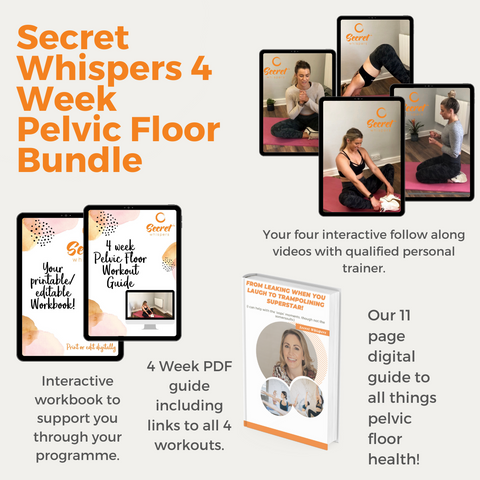Do Pelvic Floor Exercises Work?
The simple answer is - yes, pelvic floor exercises have been proven to strengthen the pelvic floor muscles and improve pelvic health.
According to recent studies and medical sources such as MedlinePlus and PubMed, pelvic floor exercises have shown significant success rates in improving symptoms related to pelvic floor dysfunction, such as urinary incontinence and pelvic organ prolapse.
In fact, research suggests that up to 70-80% of women experience improvement in their symptoms after consistently performing pelvic floor exercises.
(source: MedlinePlus and PubMed).
Am I Doing Pelvic Floor Exercises Correctly?
If you're wondering whether you're performing pelvic floor exercises correctly, you're not alone.
Many individuals are unsure if they are targeting the right muscles or executing the exercises properly.
Pelvic floor exercises are suitable for women of all ages and during pregnancy (unless your general practitioner has advised otherwise).
Here's a step-by-step guide to ensure you're on the right track:
1. Identify Your Pelvic Floor Muscles

This initial step is crucial because, surprisingly, many women (in fact, approximately half) continue to perform pelvic floor exercises incorrectly, even after receiving instructions.
This may well be a contributing factor why approximately 50% of women have a pelvic organ prolapse.
Identifying and contracting the correct pelvic floor muscles can be challenging for many individuals, as these muscles are not visible to the naked eye.
So, the easiest way I feel to best describe how to contract and exercise the correct muscle is to:
- Sit comfortably and imagine holding in wind and wee at the same time. That is the area you want to focus on and squeeze.
- Remember not to hold your breath or clench your stomach, bottom or thighs when doing these. Overtime you can build these exercises up just like any other by squeezing for a few seconds each time.
2. Get into a Comfortable Position & Start Contracting
Choose a comfortable position, whether sitting, standing, or lying down, and gently contract or squeeze your pelvic floor muscles without involving your thighs, buttocks, or abdomen.
No raised eyebrows either!
Hold the contraction for about 3-5 seconds before releasing. Please remember that the releasing slowly and resting your pelvic floor muscles between sets is equally important.
Repeat this up to 10 times for a set.
3. Gradually Increase Intensity and Duration
As you become more comfortable with the exercises, gradually increase the intensity by holding the contractions for longer periods, aiming for up to 10 seconds.
Remember to breathe freely and avoid holding your breath during contractions.
Tip - If you count out loud, you cannot forget to breath (a great tip from a previous group member).
The initial week of my 30-Day Pelvic Floor Challenges prioritizes mastering the correct techniques for pelvic floor exercises and proper breathing.
The next one starts on Monday the 8th of April 2024.
4. Maintain Consistency
Consistency is key to seeing results. Aim to perform pelvic floor exercises two to three times a day, incorporating them into your daily routine.
5. Avoid Overexertion
While it's essential to challenge your pelvic floor muscles, avoid overexertion. Start with a comfortable number of repetitions and gradually increase over time to avoid muscle fatigue or strain.
6. Seek Professional Guidance
If you're unsure about your technique or experience any discomfort while performing pelvic floor exercises, consider consulting a pelvic health specialist for personalized guidance.
How to Get the Most out of Pelvic Floor Exercises
To maximize the effectiveness of pelvic floor exercises, several strategies can be employed. Firstly, ensure you have the correct technique by following the steps outlined above.
Additionally, maintaining a healthy weight can reduce pressure on the pelvic floor muscles, improving their function.
Did you know that incorrect toilet habits can also have a negative affect on your pelvic floor?
Constipation as been showed to be significantly associated with pelvic organ prolapse (POP).
So, please always use a footstool when doing a poo.
Using pelvic floor trainers, such as Secret Whispers Kegel Weights, can also enhance the effectiveness of your workouts by providing resistance and feedback. When they are inserted your correct pelvic floor muscles will engage to hold them in. This is why they are so well recommended.
What Are the Best Pelvic Floor Exercises?
Kegel exercises are widely regarded as the best pelvic floor exercises due to their effectiveness in targeting and strengthening the pelvic floor muscles.
There are three types of Kegels you can perform, including Slow Kegels, Fast Kegels, and the 'Knack' technique.
The Slow Kegel:
- To begin, get into a position that works for you. Sitting or standing will do.
- Now, imagine holding in wind and wee at the same time. That is the areas you want to be contracting.
- Always remember to keep your breathing even and steady.
- TIP – Count out loud as it’s impossible to hold your breath then.
- Now pull up fast for up to 10 seconds.
- Rest for 5 second.
- Repeat 10 times.
- Aim to do 3 of these sets a day in combination with the Slow Kegels.
The Fast Kegel:
This technique is a fast rapid contractions of your pelvic floor muscles, which helps engage the muscles more quickly and effectively, preventing leaks when you cough or sneeze.
- To begin, get into a position that works for you. Sitting or standing will do.
- Now, imagine holding in wind and wee at the same time. That is the areas you want to be contracting.
- Always remember to keep your breathing even and steady.
- TIP – Count out loud as it’s impossible to hold your breath then.
- Now pull up fast for 1 second.
- Rest for 1 second.
- Repeat 10 times.
- Aim to do 3 of these sets a day in combination with the Slow Kegels.
The 'Knack':
This method can be 98% effective so give it a go!
Every time you go to lift anything heavy, pot plant, child, car seat etc always engage your pelvic floor so it is supported. So many women develop a prolapse suddenly because they lifted something heavy and did not support their pelvic floor.
Secret Whispers Kegel Weights are excellent for enhancing Kegel exercises, that not only teach you where your correct pelvic floor muscles, they also tighten and tone your pelvic floor muscles fast. Recommended by many pelvic floor physios as they are simple and easy to use. Just 15 minutes a day!.
In conclusion, pelvic floor exercises are indeed effective in improving pelvic health, and addressing various pelvic floor issues.
By ensuring correct technique, consistency, and incorporating additional strategies such as maintaining a healthy weight, using a footstool when having a bowel motion and using a pelvic floor trainer, individuals can maximize the benefits of these exercises for long-term pelvic wellness.
If you have concerns or experience symptoms, it's crucial to seek professional advice. For more information on pelvic prolapse and related topics, check out our blog. Feel free to explore our range of products designed to support pelvic health.
For more information on urinary incontinence and pelvic health, explore our Pelvic Floor Strengthener. Just 15 minutes a day to a stronger pelvic floor.
EXPLORE MORE ARTICLES ON PELVIC HEALTH:
- Sharing Knowledge of Pelvic Floor Exercises
- Common Misconceptions of Pelvic Floor Exercises
- Pelvic Floor Myths: Fact or Fiction?
- Pelvic Floor Diet: Foods to Improve Pelvic Health
- Pelvic Floor and Back Pain
- 27 Pages full of lots of great information.
- Recommended foods you can eat to help you naturally increase your estrogen and some fabulous recipes.
YOUR 4 WEEK PELVIC FLOOR MUSCLES WORKOUT PROGRAMME
Designed to be done anywhere and at any time. Yours to keep forever.













